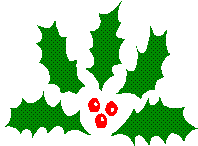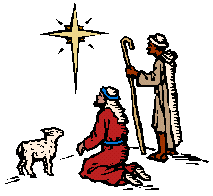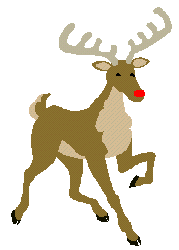

 Let's say that on December 20th you were to meet a friendly space alien. That is, let's say that his space ship discretely drops him off in your backyard while you are looking out your window. You walk outside to meet the visitor, and you find out he's a pretty nice guy. His name is say, Mr. Spock (ha ha), he is wearing a costume that makes him look passably human, (except for the ears) he speaks reasonable English, and he explains that his goal is to spend a week on the planet to learn about America and its people. He asks if you would consider being his guide for the week, and you decide to take on the job.
Let's say that on December 20th you were to meet a friendly space alien. That is, let's say that his space ship discretely drops him off in your backyard while you are looking out your window. You walk outside to meet the visitor, and you find out he's a pretty nice guy. His name is say, Mr. Spock (ha ha), he is wearing a costume that makes him look passably human, (except for the ears) he speaks reasonable English, and he explains that his goal is to spend a week on the planet to learn about America and its people. He asks if you would consider being his guide for the week, and you decide to take on the job.
So you take Mr. Spock around and start showing him your town. Since it is December 20th, one thing is for sure - Mr. Spock is going to ask about Christmas. And he is going to ask a LOT of questions, because Christmas is a pretty complicated tradition. Think about all the different questions Mr. Spock might ask:
What is Christmas?
The word Christmas comes from the words Cristes maesse, or "Christ's Mass". Christmas is the celebration of the birth of Jesus for members of the Christian religion. Most historians peg the first celebration of Christmas to Rome in 336 AD.
Christmas is both a holiday and a Holy Day. In America it is the biggest event of the year (especially for kids), and for members of the Christian religions it is an important day on the religious calendar. The federal government, all state governments, all schools/colleges/universities and the vast majority of businesses in America give employees one or two days off at Christmas, making it an important holiday (other federal holidays are: New Year's Day, Martin Luther King Day, Washington's Birthday, Memorial Day, Independence Day, Labor Day, Columbus Day, Veterans Day, Thanksgiving). In the Roman Catholic calendar, Christmas is one of 6 holy feast days celebrated in America, the others being: Circumcision (New Year's Day), Ascension, Assumption (Mary's Assumption into heaven, August 15), All Saints (November 2), and the Immaculate Conception (December 8).
Why is Christmas such a big deal?
There are two reasons why Christmas is such a big deal:
According to Daniel Boorstin in his book The Americans, Christmas was largely a non-event in America until the 1860's. 1867 was the first year that Macy's remained open until midnight on Christmas Eve. 1874 was the year of the first window displays with a Christmas theme at Macy's. It has snowballed from there.
Why does everyone give each other presents on Christmas day?
 The tradition of gifts seems to have started with the gifts that the wise men (the Magi) brought to Jesus. As recounted in the Bible's book of Matthew, "On coming to the house they saw the child with his mother Mary, and they bowed down and worshipped him. Then they opened their treasures and presented him with gifts of gold and of incense and of myrrh." As mentioned in the previous question, however, no one was really in the habit of exchanging elaborate gifts until late in the 1800's. The Santa Claus story (described below) combined with an amazing retailing phenomena that has grown since the turn of the century has made gift giving a central focus of the Christmas tradition.
The tradition of gifts seems to have started with the gifts that the wise men (the Magi) brought to Jesus. As recounted in the Bible's book of Matthew, "On coming to the house they saw the child with his mother Mary, and they bowed down and worshipped him. Then they opened their treasures and presented him with gifts of gold and of incense and of myrrh." As mentioned in the previous question, however, no one was really in the habit of exchanging elaborate gifts until late in the 1800's. The Santa Claus story (described below) combined with an amazing retailing phenomena that has grown since the turn of the century has made gift giving a central focus of the Christmas tradition.
Is December 25th really the day Jesus was born?
No one really knows. What is known is that Christain leaders in 336 AD set the date to December 25th in an attempt to eclipse a popular pagan holiday in Rome (Saturnalia) celebrating the winter solstice. Originally the celebration of Christmas involved a simple mass, but over time Christmas has replaced a number of other holidays in many other countries, and a large number of traditions have been absorbed into the celebration in the process (as we will see in sections below).

Why is there a small evergreen tree in your living room?
This is a German tradition, started as early as 700AD. In the 1800's the tradition of a Christmas Tree was widespread in Germany, then moved to England and then America through Pennsylvanian German immigrants.
Why have you decorated this evergreen with ornaments, lights, fake snow and mylar plastic tinsel?
In Victorian times, people had already started decorating trees with candies and cakes hung with ribbon. In 1880 Woolworths first sold manufactured Christmas Tree ornaments, and they caught on very quickly. Martin Luther, in the 16th century, is credited as being the first person to put candles on a tree, and the first electrically lighted Christmas tree appeared in 1882. Calvin Coolidge in 1923 ceremoniously lit the first outdoor tree at the White House, starting that long tradition. Fake snow and tinsel... Who knows? It's probably related to the song "White Christmas" (see below).
Why do you have Holly draped over the mantel and staircase?
 Mistletoe has apparently been used as a decoration in houses for thousands of years and is also associated with many pagan rituals. According to the book b by Charles Panati, "the church forbade the use of mistletoe in any form, mindful of its idolatrous associations. As a substitute, it suggested holly. The sharply pointed leaves were to symbolize the thorns in Christ's crown and the red berries drops of his blood. Holly became a nativity tradition. The Christian ban on mistletoe was in effect throughout the middle ages. Surprisingly, as late as the 20th century, there were churches in England that forbade the wearing of mistletoe sprigs and corsages during services."
Mistletoe has apparently been used as a decoration in houses for thousands of years and is also associated with many pagan rituals. According to the book b by Charles Panati, "the church forbade the use of mistletoe in any form, mindful of its idolatrous associations. As a substitute, it suggested holly. The sharply pointed leaves were to symbolize the thorns in Christ's crown and the red berries drops of his blood. Holly became a nativity tradition. The Christian ban on mistletoe was in effect throughout the middle ages. Surprisingly, as late as the 20th century, there were churches in England that forbade the wearing of mistletoe sprigs and corsages during services."
Why is mistletoe hanging over the front door?
For Scandinavians, the goddess of love (Frigga) is strongly associated with mistletoe. This link to romance may be where our tradition of kissing under mistletoe comes from.
And what about this nativity scene in the corner?
 The star, the manger, the swaddling clothes, the shepards, the angles, the heavenly host and the wise men all come from the books Matthew and Luke in the Bible.
The star, the manger, the swaddling clothes, the shepards, the angles, the heavenly host and the wise men all come from the books Matthew and Luke in the Bible.
Why is there a big log in the fireplace?
According to the book "The Dictionary of Word and Phrase Origins" by William and Mary Morris, "Yuletide for Christmastime is a term derived from the yule log, which in olden days was a huge log used as the foundation of the holiday fires. Bringing the yule log in was, as recently as the nineteenth century, as much a part of the pre-Christmas festivities as putting up an evergreen tree today. Yule can be traced back to the Middle English Yollen (cry aloud) and is thought to date from early Anglo-Saxon revels in celebration of the discovery (after the Winter Solstice, December 22) that nights were becoming shorter."
According to this page, "Up until the 19th century, the custom of burning the Yule Log flourished in England, France, Germany and among the South Slavs. Out of oak, families carved a heavy, wood block. They placed it into the floor of their hearth. It glowed throughout the year under the flames of household fires. Gradually it became ash. "
Why are there poinsettias on the hearth?
 Poinsettias were attached to Christmas starting in 1828. Joel Roberts Poinsett, then the first mexican ambassador from the United States, imported the plant from Mexico. According to the Encyclopedia Britannica, "In warm climates the poinsettia grows outdoors as a winter-flowering leggy shrub about 3 metres (10 feet) high; as a
potted plant in northern areas it rarely grows beyond 1 metre. What appear to be petals are actually coloured leaflike
bracts that surround a central cluster of tiny yellow flowers. A milky latex in the stems and leaves can be irritating to
persons or animals sensitive to it, but the claim that poinsettias are deadly poisonous is greatly exaggerated." ("Poinsettia", Britannica CD. Version 97. Encyclopaedia Britannica, Inc., 1997.)
Poinsettias were attached to Christmas starting in 1828. Joel Roberts Poinsett, then the first mexican ambassador from the United States, imported the plant from Mexico. According to the Encyclopedia Britannica, "In warm climates the poinsettia grows outdoors as a winter-flowering leggy shrub about 3 metres (10 feet) high; as a
potted plant in northern areas it rarely grows beyond 1 metre. What appear to be petals are actually coloured leaflike
bracts that surround a central cluster of tiny yellow flowers. A milky latex in the stems and leaves can be irritating to
persons or animals sensitive to it, but the claim that poinsettias are deadly poisonous is greatly exaggerated." ("Poinsettia", Britannica CD. Version 97. Encyclopaedia Britannica, Inc., 1997.)
And what about these fruit cakes?
According to "The Joy of Cooking" by Irma Rombauere and Marion Becker, "Many people feel that these cakes improve greatly with age. When they are well saturated with alchoholic liquors, which raise the spirits and keep down mold, and are buried in powdered sugar in tightly closed tins, they have been enjoyed as long as 25 years after baking."
No word yet on how they got attached to Christmas...
Why are there oversized socks hanging on your mantel?
 According to a very old tradition, the original Saint Nicholas (see below) left his very first gifts of gold coins in the stockings of three poor girls who needed the money for their wedding dowries. The girls had hung their stockings by the fire to dry. See this page for a version of this story [Note: the previous link may appear to be broken, but in fact that entire site (www.holidays.net) is currently being revamped. When they get done the link will start working again.]. Up until lately it was traditional to receive small items like fruit, nuts and candy in your stocking, but these have been replaced in the last half-century by more expensive gifts in many homes.
According to a very old tradition, the original Saint Nicholas (see below) left his very first gifts of gold coins in the stockings of three poor girls who needed the money for their wedding dowries. The girls had hung their stockings by the fire to dry. See this page for a version of this story [Note: the previous link may appear to be broken, but in fact that entire site (www.holidays.net) is currently being revamped. When they get done the link will start working again.]. Up until lately it was traditional to receive small items like fruit, nuts and candy in your stocking, but these have been replaced in the last half-century by more expensive gifts in many homes.
According to this page the tradition of a lump of coal in the stockings of naughty children comes from Italy.
Why are Christmas cards scattered all over the coffee table?
Christmas cards started in London in 1843 and in America in 1846. Today about 2 billion Christmas cards are exchanged every year in the United States.
Why do I keep hearing the same songs over and over again?
There is a set of songs that are played continuously during the Christmas Season. Here's a pretty complete list:
And why do Christmas carolers walk around the neighborhood singing?
According to this page, "In the Middle Ages in England and France, carols were dances accompanied by singing. In the French Midi, for example, the "carol" was a kind of round dance. In time, the word "carol" changed its meaning, referring only to certain kinds of songs. The Anglo-Saxon tradition favoured gathering together small choirs on the village green to sing carols and Christmas songs for the pleasure of passers-by. A number of currently very popular American Christmas carols come directly from France and England."
Why is the day before Christmas, Christmas eve, celebrated?
Christmas eve is a big deal for religious reasons such as the midnight mass, and also for retail reasons. 1867 was the first year that Macy's remained open until midnight on Christmas Eve.
Who is this Santa Claus person? And...

According to the Encyclopedia Britannica, Santa Claus started with a real person, Saint Nicholas, a minor saint from the 4th century:
Nicholas' reputation for generosity and kindness gave rise to legends of miracles he performed for the poor and
unhappy. He was reputed to have given marriage dowries of gold to three girls whom poverty would otherwise have
forced into lives of prostitution, and he restored to life three children who had been chopped up by a butcher and put in a
brine tub. In the Middle Ages, devotion to Nicholas extended to all parts of Europe. He became the patron saint of
Russia and Greece; of charitable fraternities and guilds; of children, sailors, unmarried girls, merchants, and
pawnbrokers; and of such cities as Fribourg, Switz., and Moscow. Thousands of European churches were dedicated to
him, one as early as the 6th century, built by the Roman emperor Justinian I, at Constantinople (now Istanbul). Nicholas'
miracles were a favourite subject for medieval artists and liturgical plays, and his traditional feast day was the occasion
for the ceremonies of the Boy Bishop, a widespread European custom in which a boy was elected bishop and reigned
until Holy Innocents' Day (December 28).
After the Reformation, Nicholas' cult disappeared in all the Protestant countries of Europe except Holland, where his
legend persisted as Sinterklaas (a Dutch variant of the name Saint Nicholas). Dutch colonists took this tradition with
them to New Amsterdam (now New York City) in the American colonies in the 17th century. Sinterklaas was adopted
by the country's English-speaking majority under the name Santa Claus, and his legend of a kindly old man was united
with old Nordic folktales of a magician who punished naughty children and rewarded good children with presents." ("Nicholas, SAINT", Britannica CD. Version 97. Encyclopaedia Britannica, Inc., 1997.)
"According to tradition, he was born in the ancient Lycian seaport city of
Patara, and, when young, he traveled to Palestine and Egypt. He became bishop of Myra soon after returning to Lycia.
He was imprisoned during the Roman emperor Diocletian's persecution of Christians but was released under the rule of
Emperor Constantine the Great and attended the first Council (325) of Nicaea. After his death he was buried in his
church at Myra, and by the 6th century his shrine there had become well known. In 1087 Italian sailors or merchants
stole his alleged remains from Myra and took them to Bari, Italy; this removal greatly increased the saint's popularity in
Europe, and Bari became one of the most crowded of all pilgrimage centres. Nicholas' relics remain enshrined in the
11th-century basilica of San Nicola, Bari.
It is amazing but true that the common, popular view of Santa that we all have today, along with all the crazy things around Santa like the sleigh, the reindeer and the chimney, all came largely from two publishing events that occurred in the 1800's and one advertising campaign in this century. Clement Moore wrote "The Night Before Christmas" in 1822 for his family. It was picked up by a newspaper, then reprinted in magazines and it spread like wildfire. Moore admitted authorship in 1838. If you read the poem you will find that he names the reindeer, invents the sleigh, comes up with the chimney and the bag of toys, etc. Nearly everyone in America has been able to recognize or recite this poem since the 1830s.
Then, between 1863 and 1886, Harper's Weekly (a popular magazine of the time) ran a series of engravings by Thomas Nast. From these images come the concepts of Santa's workshop, Santa reading letters, Santa checking his list and so on. Coca-cola also played a role in the Santa image by running a set of paintings by Haddon Sundblom in its ads between 1931 to 1964.
The red and white suit came, actually, from the original Saint Nicholas. Those colors were the colors of the traditional bishop's robes.
See also A Brief History of Santa for a good set of Santa pictures.
Who is this one reindeer at the front named Rudolf, with the biological aberration of a red, glowing nose capable of penetrating thick fog?
 The whole story of Rudolf appeared, out of nowhere, in 1939. Santas at Montgomery Ward stores gave away 2.4 million copies of a booklet entitled "Rudolf the Red-Nose Reindeer." The story was written by a person in the advertising department named Robert May, and the booklet was illustrated by Denver Gillen. The original name of the reindeer was not Rudolf, according to the book Extraordinary Origins of Ordinary Things by Charles Panati. The original name was Rollo, but executives did not like that name, nor Reginald. The name Rudolf came from the author's young daughter! In 1949, Gene Autry sang a musical version of the poem and it was a run-away best-seller. The Rudolf song is second only to "White Christmas" in popularity.
The whole story of Rudolf appeared, out of nowhere, in 1939. Santas at Montgomery Ward stores gave away 2.4 million copies of a booklet entitled "Rudolf the Red-Nose Reindeer." The story was written by a person in the advertising department named Robert May, and the booklet was illustrated by Denver Gillen. The original name of the reindeer was not Rudolf, according to the book Extraordinary Origins of Ordinary Things by Charles Panati. The original name was Rollo, but executives did not like that name, nor Reginald. The name Rudolf came from the author's young daughter! In 1949, Gene Autry sang a musical version of the poem and it was a run-away best-seller. The Rudolf song is second only to "White Christmas" in popularity.
Why does everyone, even Floridians, dream of a white Christmas?
The song "(I'm Dreaming of a) White Christmas", written by Irving Berlin for the movie "Holiday Inn" (1942) and sung by Bing Crosby, is one of the best selling songs of all time.
Why is Christmas sometimes spelled Xmas? Especially when combined with the word "Sale"?
According to the book "Did you ever Wonder..." by Jeff Rovin, the word for Christ in Greek is Xristos. The use of the shortened form Xmas became popular in Europe in the 1500's.
The word Xmas is so common in advertising most likely because "Xmas" and "Sale" have the same number of letters, and "Xmas" is significantly shorter than Christmas.
And why are stores and malls so geared up about this holiday? Why does every mall have a Santa village, and why do kids come sit on Santa's knee?
As mentioned above, stores and malls have been revved up about Christmas since the late 1800's. In America today the weeks between thanksgiving and Christmas are, by far, the biggest retail sales weeks of the year. The survival of most retail stores depends on the Christmas buying season. Therefore retailers do whatever they can to whip people into a Christmas buying spirit and to attract them to their stores. Festive decorations, big ads, Santa's Villages and all the rest is a part of that process.
So...
So admit it - you never knew all of this stuff about Christmas! I know I didn't, and it certainly was fun learning all about the history of this holiday and Holy Day. Here's some links if you want to learn more:

